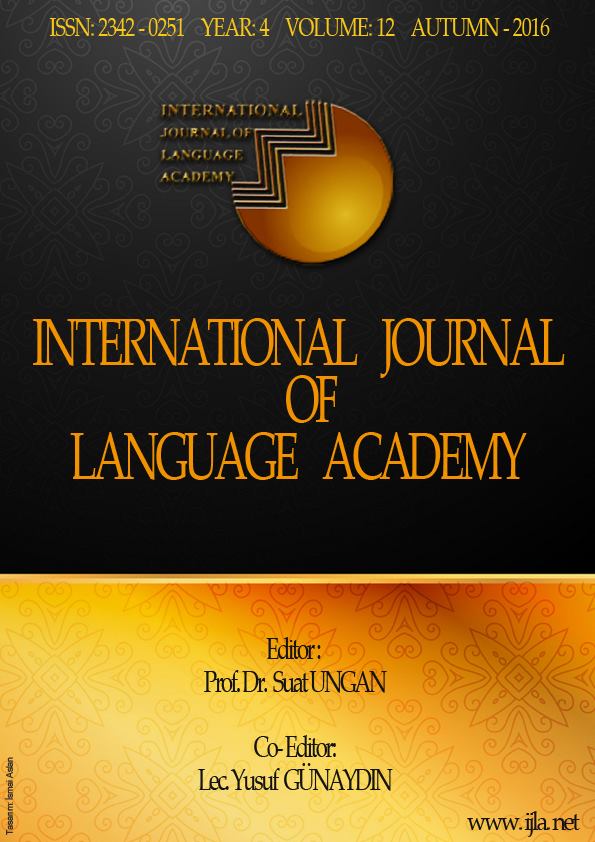Author :
Abstract
Alternatif değerlendirme formu olarak kullanılan portfolyolar öğrencilerin başarı ve bilgilerini ölçen bir derlemedir. Öğrenci merkezli yöntemlerin ve portfolyoya bağlı yararların sonucu olarak daha fazla öğretmen, öğrenci gelişimi ve değerlendirmesi için bu aracı kullanmaktadır. Bu ilgi sebebiyle, bu çalışma Türkiye’deki büyük bir devlet üniversitesindeki öğretmen ve öğrencilerin yabancı dil öğretimi sınıflarında kullanılan yazma portfolyoları hakkındaki görüşlerini incelemektedir. Ayrıca bu çalışma portfolyoların avantaj ve dezavantajlarının yanında portfolyoların öğrenme sürecindeki etkilerine dikkat çekmektedir. 12 öğretmen ve 100 öğrenci çalışmaya katkıda bulunmuştur. Tarama türü araştırma yöntemi kullanılmıştır ve anketler yoluyla hem öğretmen hem de öğrencilerden veriler toplanmıştır. İkili ve çoklu karşılaştırmalarda Kruskal Wallis ve Mann Whitney U testleri uygulanmıştır. Her iki anket de .707 (öğretmen) ve .722 (öğrenci) alpha değerleri ile güvenilir bulunmuştur. Araştırma, öğretmenlerin portfolyo ve portfolyonun dil öğrenimi üzerindeki etkisi hakkında olumlu görüşe sahip olduğunu göstermektedir. Sonuçlar portfolyonun bir çok avantajının olduğunu göstermesine rağmen, portfolyo kullanımının bazı dezavantajları da öğretmen ve öğrenciler tarafından tanımlanmıştır. Bulgular, öğretmenlerin portfolyoların öğrencilerin öğrenmelerine yardımcı olduğunu düşündüklerini, öğrencilerin ise portfolyoların dil öğrenimine yönelik etkilerinden emin olmadıklarını göstermektedir.
Keywords
Abstract
Used as an alternative form of assessment, portfolios are a collection of students’ work, which demonstrates students’ achievement and knowledge. As a result of learner-centered methodologies and benefits associated with portfolios more and more teachers are using them for learner development and assessment. Due to this interest, the current study investigates opinions of teachers and students towards using writing portfolios in language learning classrooms at a large state university in Turkey. The study focuses on advantages, disadvantages, and effects of writing portfolios on students’ learning process. 12 teachers and 100 prep-school students contributed to the study. Survey type research design is used and data were gathered both from teachers and students’ via questionnaires. For dual and multiple comparisons Kruskal Wallis and Mann Whitney U Tests were conducted. Both questionnaires were found reliable with .707 (teacher) and .722 (student) alpha values. The results showed that the majority of teachers have positive opinions and perceptions regarding portfolio keeping and its effects on language learning. However, the students were mostly dubious regarding the effects and benefits of portfolios. Although the research indicates a lot of advantages, some drawbacks of keeping portfolios were also identified by teachers’ and students’. The findings show that teachers think portfolios are helpful to students’ learning while students are uncertain about the effects of portfolios in learning English.
Keywords
- Abhakorn, M.L.J. (2015). Investigating the use of student portfolios to develop students’ metacognition in English as a foreign language learning. Journal of Language Teaching and Research, 5(1), 46-55.
- Arslan, R. Ş. (2014). Integrating feedback into prospective English language teachers’ writing process via blogs and portfolios. TOJET: The Turkish Online Journal of Educational Technology, 13(1), 131-150.
- Aydın, S. (2010). A qualitative research on portfolio keeping in English as a foreign language writing. The Qualitative Report, 15(3), 475-488.
- Aydın, S. (2010). EFL writers’ perceptions of portfolio keeping. Assessing Writing 15, 194- 203.
- Aydın, S. (2014). EFL writers' attitudes and perceptions toward F-Portfolio use. Tech Trends, 58(2), 59-77.
- Caner, M. (2010). Students views on using portfolio assessment in EFL writing courses. Anadolu University Journal of Social Sciences, 10(1), 223-236.
- Carole, N., & Lynn, S. (2006). Promoting learning for English language learners with portfolios four case studies. Ohio Reading Teacher, 38(1), 53-64.
- Creswell, J. W. (2009). Research design: Qualitative, quantitative and mixed-methods research (Third Edition). California, USA: Sage Publications.
- Dörnyei, Z. (2007). Research methods in applied linguistics: Qualitative, quantitative and mixed-methodologies. Oxford, UK: OUP.
- Fahim, M., & Jalili, S. (2013). The impact of writing portfolio assessment on developing editing ability of Iranian EFL learners. Journal of Language Teaching and Research, 4(3), 496-503.
- Fernsten, L., & Fernsten, J. (2006). Portfolio assessment and reflection: enchancing learning through effective practice. Reflective Practice, 6(2), 303-309.
- Ghoorchaei, B., Tavakoli, M., & Ansari, D.N. (2010). The impact of portfolios assessment on Iranian EFL students’ essay writing: a process-oriented approach. GEMA Online Journal of Language Studies, 10(3), 35-51.
- Hamp-Lyon, L., & Condon, W. (1993). Questioning assumptions about portfolio-based assessment. College Composition and Communication, 44(2), 176-190.
- Hirvela, A., & Sweetland, Y.L. (2005). Two case studies of L2 writers’ experiences across learning-directed portfolio contexts. Assessing Writing 10, 192-213.
- Kabilan, M.K., & Khan, M.A. (2012). Assessing pre-service English language teachers’ learning using e-portfolios: benefits, challenges and competencies gained. Computers & Education, 58, 1007-1020.
- Nezakatgoo, B. (2011). The effects of portfolio assessment on writing of EFL students. English Language Teaching, 4(2), 231-241.
- Paulson, L. F., Paulson, P.R., & Meyer, A.C. (1991). What makes a portfolio a portfolio? Educational Leadership, 48 (5), 28-31.
- Rao, Z. (2006). Helping Chinese EFL students develop learner autonomy through portfolios. Reflections on English Language Teaching, 5(2), 113-122.
- Song, B., & August, B. (2002). Using portfolios to assess the writing of ESL students: a powerful alternative? Journal of Secong Language Writing, 11, 49-72.
- Wilcox, B. (1997). Writing portfolios: Active vs. passive. The English Journal, 86(6), 34-37.
- Yang, N. (2006). Integrating portfolios into learning strategy-based instruction for EFL college students. IRAL-International Review of Applied Linguistics in Language Teaching, 41(4), 293-317.





